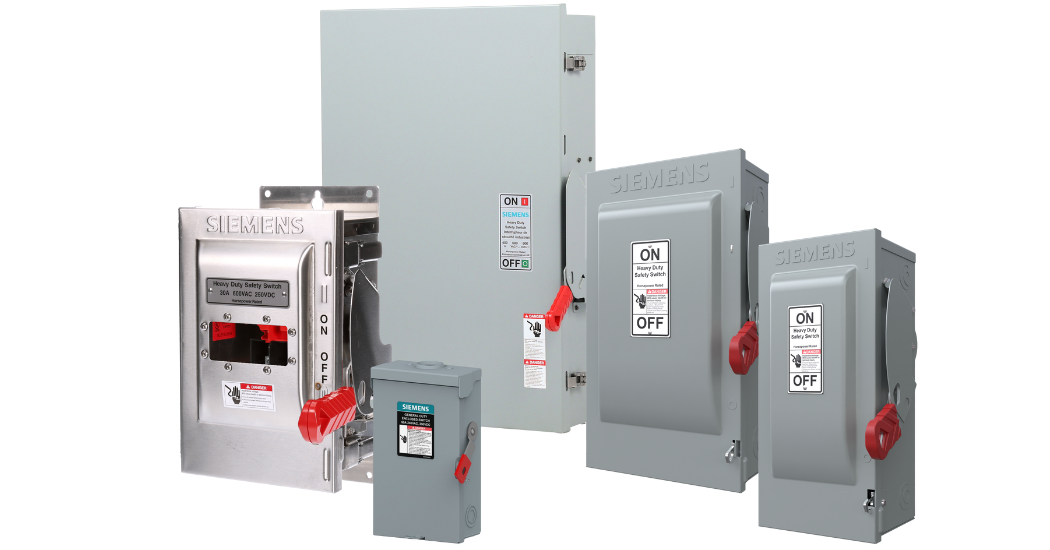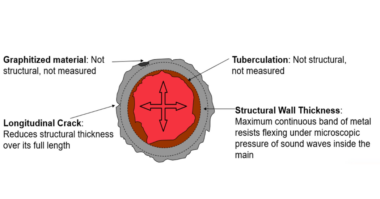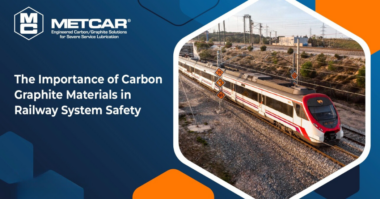Siemens technology provides safety in a wide variety of industrial and commercial applications.
From remote agricultural and farmland applications to dusty oilfields, cargo ships, car washes, steel mills, chemical plants, and even mining operations, enclosed safety switches and circuit breakers provide rugged, reliable flexibility and crucial safety when operations need to be shut down automatically and immediately.
This is important for code reasons as well as for safety reasons. Siemens offers a robust VBII switch as well as 3VA circuit breakers as reliable options for when operations need to be shut down. But there are a few distinct differences between the two.
The Siemens Safety Switch line offers many important features that provide a competitive edge, including visible blade construction, viewing window, a quick break mechanism, copper current-carrying parts, and an easy-to-grip handle for manual shutdown. The VBII double-break switching action breaks the arc in two places. This reduces heat generation and increases switching speed by doubling the breaking distance.
Molded case circuit breakers are ideal for machine and switchgear manufacturers who export worldwide. The system complies both with the UL standard and the IEC standard. This enables you to take advantage of all functionalities for systems that are used in North America as well as in Europe. In addition, they are compliant with the relevant standards.
 In a pump panel and in an enclosed soft starter, a fusible disconnect or a circuit breaker is the best option. The circuit breaker option works automatically or with a manual lever to turn the circuit off and on. It’s designed to break all phases of the circuit if there is a fault or an overload condition. Many end users prefer the reset ability of the circuit breaker, however, others like the fused for flexibility or possibly non-fused safety switches when applicable.
In a pump panel and in an enclosed soft starter, a fusible disconnect or a circuit breaker is the best option. The circuit breaker option works automatically or with a manual lever to turn the circuit off and on. It’s designed to break all phases of the circuit if there is a fault or an overload condition. Many end users prefer the reset ability of the circuit breaker, however, others like the fused for flexibility or possibly non-fused safety switches when applicable.
In the field, safety switches are commonly used as a disconnect of power to keep personnel and the equipment safe. Operators can feel confident that when the disconnect switch is in the off position and locked out, maintenance or service can be safely accomplished.
“It’s not a good idea to have a pump application out there without a disconnect switch for the motor,” explains Siemens’ Aaron Klein. “Whether it’s in its own little gray box or whether it’s inside a pump panel, there’s a necessity to have the disconnect capability—not just because it’s required for code reasons, but more important, for safety reasons.”
Klein says disconnect switches are one of the most universal products used for just about any application. “Safety switches or disconnect switches are in every building, every house, everywhere on the planet,” he says. “Even your air conditioning and your furnace has a disconnect switch. From oilfield pumpjacks to the pool pump in your backyard, every motor should have a disconnect switch.”
The Siemens VBII heavy-duty disconnect switch has visible blades for safety and double break switch action to reduce arcing and increase lifetime.
Unlike conventional knife blade switches, the visible blades are self-aligning to ensure positive contact. They have no wear and friction point since the “electrical hinge” has been eliminated. The result is a very fast, positive, and reliable switching action for even the most severe applications.
Along with the visible blade design, the viewing window makes Siemens switches unique and extra safe.
“When you turn the switch off and complete lockout tagout, say for preventative maintenance, some utilities require that you visually see that the blades are not engaged before you open any cabinet doors,” explains Siemens’ Joseph Kreisel. “Most manufacturers are now moving toward a visible blade type and then with the optional viewing window. This enables you to ensure that the blades are locked out of position.”
An additional safety feature is the door interlocking system with defeater on most models. If the motor is running, the operator is prevented from opening the panel door.
“One common use is for a multiple motor application where you have maybe one main disconnect that’s feeding multiple controllers or multiple motor starters,” explains Kreisel. “You might have a pump house where the controllers are inside the building, but maybe the utility meter and the main disconnect switch must be on the outside. This is a reason for separate disconnect, but if you are using only one controller like a pump panel, you likely can avoid having a separate disconnect and separate motor starter. You can have it all in one package—resulting in savings as well as fewer components for the customer.”
There are some noteworthy differences between a disconnect switch and enclosed circuit breaker. A switch is designed to switch power “on” and “off” manually. By contrast, a circuit breaker is designed to “break” the circuit by itself in a fault or overload condition. Both Siemens VBII disconnect switches and Siemens 3VA enclosed circuit breakers have a high number of mechanical operations for long service life. All Siemens disconnect switches meet all NEC codes and the requirements for lockout-tagout (LOTO).
In some markets, the reduced amount of part numbers of the circuit breaker is preferred by end users, however, others prefer the flexibility of the fused safety switches. Sizes can be adjusted specifically for the voltage, amperage, and horsepower of the motor.
One advantage of the fusible disconnect switch is the initial lower cost. However, those savings reduce over time and fused switches possibly become more costly by having to continually replace fuses. In contrast, the key advantage of the circuit breaker is that if it trips, it’s easily resettable without the need to replace any fuses. The resettable feature of the circuit breaker is one of the biggest differences between the two designs.
No matter the choice, both the Siemens circuit breakers and disconnect switches provide reliability and meet regulatory codes for safety.
For more information:
usa.siemens.com/3VA
usa.siemens.com/switches





Comments